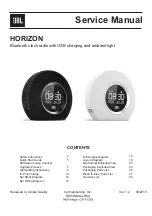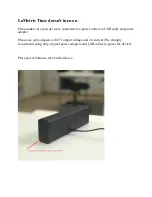
Artikelnummer - article number - numéro d’article: 672036 & 672037
3
ENGLISH
Intended use
The purpose of the radio-controlled wall clock is to decode the DCF-radio signal and to display the time.
It may only be used indoors; do not use outdoors. Contact with moisture, for example in bathrooms, must be avoided.
The radio-controlled wall clock is only approved for battery powered operation. Do not use any other power source.
Any use other than described is not permitted and can damage the product. In addition, it can lead to dangers such as short-circuit,
fire and electrical shock.
The safety instructions have to be followed without fail!
This product complies with the applicable National and European specifications.
The Declaration of Conformity CE is available by the addressee:
Conrad Electronic SE, Klaus-Conrad-Str.1 in 92240 Hirschau / Germany
Safety Instructions
The warranty will be void in the event of damage caused by failure to observe these safety instructions. We do not
assume liability for any resulting damage.
We do not assume any liability for material and personal damage caused by improper use or non-compliance with
the safety instructions. The warranty will be void in such cases.
•
For safety and approval (CE) reasons, unauthorised conversion and / or modifications to the product are not permitted.
•
Do not expose the product to high temperatures, strong vibrations or heavy mechanical loads like push and fall.
•
If you have any doubts about the correct operation or about the sufficient fixing of the product on the wall, please consult a
specialist. On the fixing affects a static load of max. 6 kg as weight.
•
Keep the product and the batteries out of the reach of children. They are not toys.
•
Do not leave packing materials unattended. They may become dangerous playthings for children.
The
Functional
Principle
of
the
radio
‐
controlled
clock
The
RC
clock
receives
time
frame
signals
from
the
transmitter
DCF77
by
the
built
‐
in
antenna
system.
Once
it
has
been
set
correctly
by
the
time,
the
RC
clock
continues
running
on
its
own,
internal,
comparing
the
indicated
time
with
the
time
information
of
the
transmitter
DCF77
once
every
hour.
The
best
position
The
clocks
reception
system
is
virtually
omni
‐
directional,
which
makes
it
possible
to
position
the
clock
for
the
best
visual
effect.
Use
screws
with
wall
plugs
for
mounting.
Respecting
good
receiving
conditions
always,
the
radio
‐
controlled
clock
must
not
be
secured
to
metallised
surfaces.
Connection
of
an
external
antenna
If
a
particular
place
of
installation
does
not
guarantee
good
reception
conditions,
an
external
antenna
can
be
connected
easily
to
the
movement
by
means
of
a
jack
plug
to
improve
reception
immediately,
without
of
any
manipulation.
It
is
to
order
separately,
also
later
onwards.
Starting
the
radio
‐
controlled
clock
Insert
two
1.5
V
batteries
the
correct
way
round
(LR
14
alkaline).
The
second
hand
and
hour
hand,
and
afterwards
the
minute
hand,
move
automatically
in
rapid
motion
to
“12.00”
‐
position
‐
the
reception
phase
begins.
When
the
RC
clock
movement
receives
the
time
frames
the
second
hand
begins
to
move
in
1
‐
second
steps.
The
minute
hand
also
begins
to
move.
After
2
minutes
of
receiving
time
the
second
hand,
minute
hand
and
hour
hand
simultaneously
set
themselves
automatically
to
the
correct
time
in
rapid
motion.
If
the
LED
flashes
and
the
second
hand
moves
erratically,
this
means
that
perfect
reception
is
not
possible
at
the
present
moment
and
the
reception
phase
is
extended
for
a
certain
period
of
time.
Reception
monitoring
display
The
clock
receives
a
time
frame
in
the
59
th
minute
of
each
hour
and
the
internal
time
memory
is
synchronized
accurately
to
the
second.
As
sign
for
this,
the
minute
hand
continues
to
jump
from
full
minute
to
full
minute.
If
perfect
reception
is
not
possible,
the
minute
hand
changes
to
a
virtually
continuous
motion,
i.e.
the
minute
hand
moves
to
a
total
of
30
intermediate
positions
each
minute.
This
near
continuous
motion
does
not
change
back
to
a
motion
in
one
‐
minute
steps
until
perfect
radio
contact
occurs
at
a
later
full
hour.
Battery
change
display
“low
‐
batt”
With
this
clock
the
battery
voltage
is
checked
several
times
each
day.
If
it
drops
below
the
limit
voltage
it
will
be
indicated
visually
by
the
LED
flashing
at
10
‐
second
intervals,
although
there
is
still
sufficient
power
reserve
for
reliable
operation.
























